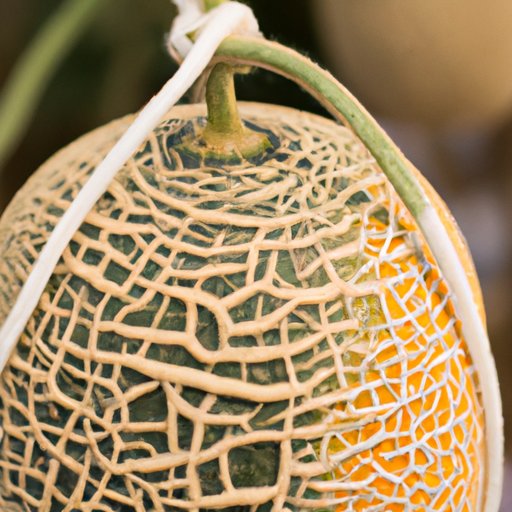
I. Introduction
Picking the perfect cantaloupe can be a daunting task, especially for those who don’t know what to look for. With so many options available in the market, it’s easy to get overwhelmed and end up buying a bad cantaloupe. Fortunately, with a little practice and knowledge, anyone can learn how to select the best cantaloupe by using some simple techniques and tips. In this article, we’ll be going over the most important methods for picking the perfect cantaloupe in detail.
II. Use Your Senses
When picking a cantaloupe, it’s essential to use all your senses: sight, smell, and touch.
Sight
Visually inspecting the cantaloupe can tell you a lot about its ripeness. Look for a cantaloupe that has a smooth, even surface with no dents or cuts. A flawed surface might indicate that it has been damaged during harvesting, shipping, or storage, which can cause the fruit to spoil.
Smell
A ripe cantaloupe should have a sweet and fragrant aroma. To determine whether a cantaloupe is ripe or not, bring it close to your nose and smell it. If it has a sweet and enticing smell, then it’s a sign that it’s ready to eat. However, if you smell a sour or unpleasant odor, it’s an indication that the cantaloupe has gone bad.
Touch
The texture of the cantaloupe skin can also provide valuable information on its ripeness. The skin of a ripe cantaloupe should be slightly firm but not too hard. When you run your hands over the cantaloupe, you should feel a slight give, which signifies that it’s ready to eat. If the skin gives too much, then it’s past its best and might be spoiled.
III. Look for the Right Shape
The shape of a cantaloupe can also help identify its ripeness. The ideal cantaloupe should have a symmetrical shape with no obvious bulges or dents. If you notice any unevenness or misshapen spots on the fruit, it’s a sign that it might be under-ripe and not sweet.
IV. Check the Stem End
The stem end of a cantaloupe can provide some clues about its ripeness. When examining the stem end, look for a small indentation or a slight crack around it. This is a sign that the cantaloupe is ripe and tends to detach from the vine naturally. If there is no indentation or cracking around the stem, it indicates that the cantaloupe might still be unripe, and it warrants extra attention during the other checks.
V. Consider the Weight
Weight can be another indicator of ripeness. A ripe cantaloupe should feel heavy for its size. When you hold the cantaloupe in your hand, it should feel weighty and dense. However, if the cantaloupe feels light, it’s an indication that it’s not fully ripe.
VI. Tap It
Tapping the cantaloupe can also help determine its ripeness. When you tap a ripe cantaloupe, it should have a deep and hollow sound. This is an indication that the fruit is full of water, and it’s ready to eat. On the contrary, if the sound is dull or indicates that the inside of the fruit is empty, then the cantaloupe might be under-ripe or spoiled.
VII. Avoid Bruises or Soft Spots
The presence of bruising or soft spots on a cantaloupe is a red flag that indicates that the fruit might not be consumable. Soft spots can be an indicator of spoilage, while bruises might indicate that the fruit has been mishandled. Be sure to check the skin of the cantaloupe carefully to ensure it’s free of any soft areas or bruises.
VIII. Look for the Right Color
The color of the cantaloupe can also help identify its ripeness. A ripe cantaloupe should have a distinct yellow color around the netting. If the fruit has a green tint, it’s not ripe yet and needs more time to ripen. Moreover, the skin of a ripe cantaloupe should also have less green and more yellow, indicating that it’s ready to be consumed.
IX. Conclusion
By using these simple techniques and tips, anyone can pick the perfect cantaloupe. Remember to use your senses, inspect the shape, examine the stem end, check for weight, tap it, and avoid any soft spots or bruises. By following these steps, you’ll be able to select a ripe and juicy cantaloupe every time.
So, don’t hesitate to put your skills to the test and pick out your next cantaloupe confidently.





